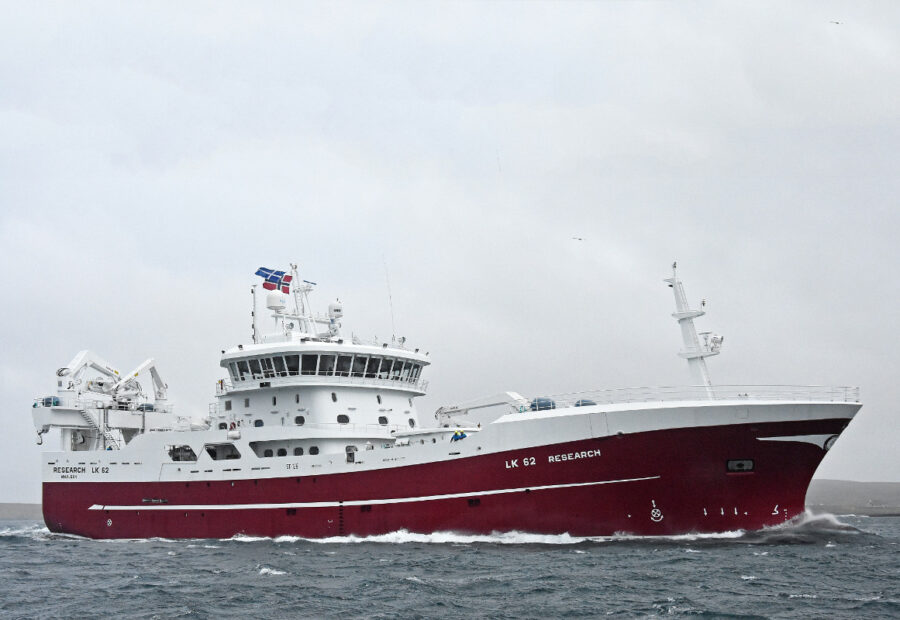Being the first Scottish pelagic vessel featuring electric-drive deck machinery, the new Whalsay 80m midwater trawler Research LK 62 makes a significant contribution to the continual evolution of vessel design, in which Shetland skippers have a strong track record, reports David Linkie
Research is also the first vessel in the world equipped with electric fish pumps, supplied – together with the deck machinery – by Rapp Marine, and it is powered by a Wärtsilä main engine that is included in Guinness World Records for being the most fuel-efficient engine of its type. This further highlights the degree of technical innovation and forward-thinking that the Research Fishing Company has embraced with its new vessel.
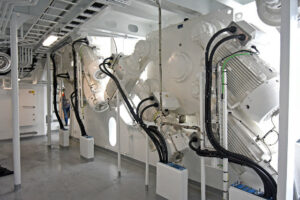
Two 110t net drums on the shelterdeck are driven by eight electric motors…
A 1,500kW Azimuth thruster forward, along with an enclosed MMC fish/seawater separator on the boat deck, three seawater refrigeration plants, and a SeaQ video matrix fishing/navigation display in the wheelhouse, further underline the vessel’s high level of specification, and the extent to which the owners have embraced modern technology and design.
Pelagic fish are pumped aboard at the stern. Midwater trawl gear is worked from shelterdeck level, where wide boat decks, continued across the transom, provide maximum operational safety for the crew.
After rigging out at Lerwick for fishing trials southeast of The Bard – an area favoured by herring drifters in a previous era – skippers Gary and Richard Williamson and Research’s crew quickly started fishing at the beginning of this month. Appropriately for a vessel featuring electric-drive deck machinery, Research made a high-voltage start on Guy Fawkes Day, when four smooth tows and the subsequent fish-pumping operations, close in to the west side of Shetland, southeast of Foula, each yielded 500t of prime-quality MSC-accredited mackerel.

… remotely operated through cabinets in a dedicated room on the main deck…
Designed by Skipsteknisk AS of Ålesund, Research was built in Norway by Vard Langsten, as a replacement for the owners’ previous 14-year-old 78.5m midwater trawler of the same name, which was renamed Borgarin KG 491 by new owners P/F Næraberg-Faroe Islands 20 months ago, when the contract to build the new boat was signed.
Featuring a round bilge hull, Research has an LOA of 79.8m, length between p.p. 72.6m, 16.2m of beam, moulded depth (main deck) 6.5m, and a scantling draught of 8m.
Research effectively features three continuous decks – main, shelter and boat – together with a sleek forecastle deck housing the anchor windlasses, mooring platforms/winches, and two 80t anti-roll tanks.
With a capacity of 2,819m³, Research’s 11 RSW tanks are arranged from forward in four tiers of three, two, two and four. The two middle tiers are positioned adjacent to the hull sides, to create a large central area in which the vessel’s RSW pumping system, refrigeration machinery and vacuum landing plant are housed over three decks amidships.
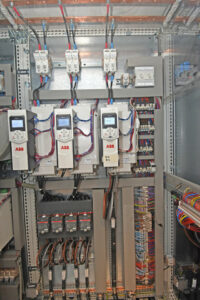
… housing state-of-the-art control panels.
Below the main deck, the hull is subdivided into forepeak seawater ballast tank, sonar compartment, Azimuth thruster room, forward insulated RSW tanks, refrigeration compressors, aft insulated RSW tanks, and engineroom.
At main deck level, the arrangements from forward are forepeak, upper thruster room, RSW trunk section, vacuum landing/refrigeration plant rooms, aft RSW trunking, laundry, engine control room/electrical rooms/four accommodation cabins (starboard), engineer’s workshop (port), steering gear compartment, and net store.
Layout on the shelterdeck consists of forepeak, electric control room, workshops, tank deck with loading pipes for RSW tanks, pumping/vacuum landing control room, crew deck wardrobe, four accommodation cabins and hospital.
The boat deck is arranged with forecastle housing anchor/mooring winches, hydraulically operated mooring platforms, and integrated roll damping tanks. The fish/seawater separator forward of the accommodation casing is surrounded on three sides by a central deck house, the starboard side of which houses a fish-sampling room.
The immaculately finished messdeck, in which three circular tables are arranged, is positioned across the forward part of the main deck house, adjacent to a smaller lounge area to starboard.
Cook Alec John Polson has a wide range of equipment available to use in the portside galley, which leads aft to the customary walk-in dry provisions store, together with separate fridge/freezer rooms, which can also be accessed off the boat deck. All cardboard packing from the domestic stores is stored onboard, after being compacted and baled in an Orwak Compact unit, prior to being put ashore for recycling.
A further six single-berth en suite cabins are arranged on the deck above the day areas.
Fish pumping
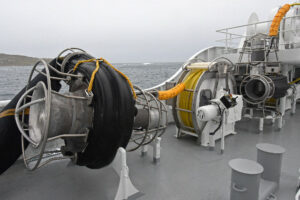
Electric-drive fish pumps and cable reels are located on the wide portside boat deck…
The owners of Research are the latest to opt for pumping pelagic fish at the stern, rather than the former location of amidships on the starboard side, the origins of which go back to the days of purse-seining, when initially herring were brailled aboard.
When using the net drum to dry up the brailler, the 44t tailend winch, mounted to port on the upper boat deck, is used to haul the bag back to the quarter, before the sock is attached to the fish pump located on the wide boat deck, just forward of the trawl gantry.
Research is also the first pelagic vessel to use an electric rather than a hydraulic fish pump. The main advantages of electric fish pumps are:
- More energy-efficient
- Environmentally friendly – no hydraulic hoses to leak
- Easier to handle and store the power cable. One 2in OD electric cable takes up less space than two of the larger hydraulic hoses, enabling a smaller storage reel to be used than that required for the two pipes associated with hydraulic fish pumps.

… above the fish hose reels and large-diameter pipe…
With the capacity to pump up to 1,200t of pelagic fish per hour (20t/minute), the two electric-drive fish pumps on Research are a new product from Rapp Marine. The VFD pumps have a new geometric shape, developed to give better fish quality and pumping control, and are driven by an oil-filled and pressure-compensated electric motor. The new system on Research includes electric cable reels and a newly developed control system.
The fish pumps and cable reels are located on the portside boat deck, directly above two larger-diameter reels on the main boat deck, on which the fish hoses are stored.
The fish hose permanently connected to the pump sits in a captive vertical slot in the port side of the transom, allowing the hose to run clear of the stern as the pump is lowered into the water.
When the rubber hose is connected, fish are pumped some 35m forward, through a large-diameter stainless steel delivery pipe, inboard towards the fish/seawater separator system.
A short clear Perspex section (the looking glass), incorporated into the first section of the main pipe, enables the crewman controlling pumping operations to constantly monitor the flow of fish.

… that delivers pelagic fish forward to the enclosed dewatering unit on the boat deck amidships.
When pumping, the flow of pelagic fish from the separator into the 11 RSW tanks is remotely controlled from either the main pump room, located in the accommodation casing overlooking the tank top area, or from the secondary deckhouse.
On entering the water separator, fish are directed upwards before sliding either forward or aft into transverse troughs, from which they are directed to the allocated RSW tank by remotely operated vertical gate valves.
The large-diameter stainless steel pipes that lead from the separator are routed through the shelterdeck to enter the RSW tanks from the side, thereby leaving the tops clear for the crewmen to easily observe the level of fill.
As is now fairly standard on new pelagic vessels, pivoting grid boxes are mounted on one side of the tank tops, as well as the usual hatch covers. While fish are entering the tanks at the same time as seawater is being pumped in, the grids are lowered in place and secured. This practice ensures optimum levels of water quality, and therefore fish quality. Water and any floating waste overspills from the tanks through the grid cover, and is retained in deep coamings around the tank tops, rather than flowing across the deck. Excess water is continually drained through deck grids, and returned to the sea via the moon pool located in the centre of the RSW manifold room three decks down, through which all seawater exits the boat.
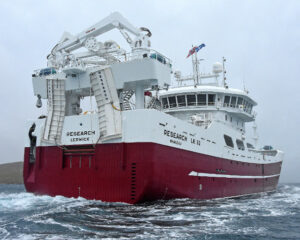
Stern view of Research.
With buyers worldwide requiring ever-higher standards of catch quality, the owners placed particular emphasis on Research landing a top-quality product, by being able to reduce the temperature of pelagic fish entering the RSW tanks to an optimum storage temperature of between 0°C and 1°C as quickly as possible.
Three ammonia-based refrigeration plants from MMC, which supplied all the catch-handling and discharge systems, deliver 3.2mKcal/h of cooling capacity, enabling pelagic catches to be brought down to the desired temperature of -1.3°C/-1.5°C in the minimum timescale. The RSW system is served by 3 x 700m³/h coolers, 3 x 700m³/h circulation pumps and 3 x 273m³/h condenser pumps. Should the need arise, the system can be configured so that one pump can supply water through the three refrigeration plants in succession, to pull seawater temperature down extremely quickly.
Fish quality is further enhanced by circulating purified seawater, supplied from a Normex ozone plant, through the 11 RSW tanks when the vessel is steaming, before the next shot of pelagic fish is pumped aboard.
Pelagic catches from Research are discharged to processing factories ashore by twin MMC 4,200-litre vacuum pumping systems. Operated by 4 x 87kW compressor units, the system has a delivery rate of 150t/200t per hour.
Midwater trawls
Research is using new midwater trawls custom-built by Jackson Trawls of Peterhead and Swan Net-Gundry of Killybegs/Lerwick.
Having fished consistently well in the past with midwater gear from these two well-known netmaking companies, skippers Gary and Richard Williamson had no hesitation in ordering their new fishing gear from SNG and Jackson’s.
Jackson Trawls built a 1,000m dual-purpose mackerel/herring trawl in twisted nylon, complete with an eight-panel tunnel with last section T90. Eight-strand Dynamica was incorporated into the design to protect the head and side ropes.
This net is an updated model of the trawl used on the previous Research. This fished well for herring, and especially for mackerel, in the shallow waters around Shetland.
Swan Net-Gundry
Swan Net-Gundry is delighted to continue its long association with the owners of the new Research, which spans over 25 years, and was extremely proud to receive the order from skippers Gary and Richard Williamson. This demonstrates SNG’s knowledge of their requirements and of the industry, to offer the very best solutions and products now being used onboard Research.
Through SNG’s extensive research and development, and consultation process with its customers, it designed an extensive package of midwater gear for Research that is now proving to be extremely successful, with excellent results reported.
The package included a 1,280m mackerel trawl incorporating Helix twine in the top and sides of the net, offering optimum vertical opening and horizontal spread that has delivered consistent results for SNG customers. Through extensive research and development, and flume tank explorations, the new eight-panelled back-end has resulted in an increased water flow in the tunnel sensor area, to ensure clean fishing on mackerel, horse mackerel and herring.
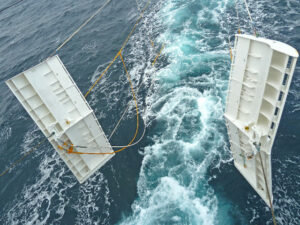
Research is using a set of Thyborøn Type 20 Slider 16m²/1,400kg trawl doors, to spread the midwater trawls.
The second trawl was a 1,024m Helix trawl. This featured an array of smaller meshes, offering Research greater herding capabilities while fishing for herring. The trawl has been very successful as a dual-purpose trawl, as it was used on the previous Research to target mackerel, proving to be an excellent net for both pelagic species, especially in shallow fishing grounds.
Three 65m wide-bodied fast-flow braillers with eight panels incorporated in the construction were developed by SNG design. To create more flare in the brailler, the SNG team introduced Dynice bands of netting on the top and tail splitter with Swan-Lock handles, eliminating the need for conventional steel rings. In order to solve the problem of shrinkage on the pumping section of the brailler, Dynice netting was also incorporated on the inside and outside. This solution offers easy handling for crew when attaching the codend to the fish pump.
SNG also supplied a 2,355m blue whiting trawl with Helix self-spreading. This trawl was constructed with 51.2m mesh in the wings and square, along with a newly designed eight-panel back-end, complete with rib-lines for improved water flow. It was accompanied by three 41-fathom blue whiting braillers that feature new stronger outside covers with 46 high-strength restricting ropes for the braillers.
The SNG Dynice Data cable supplied for the trawl sonar/sounder has two main features. It is considerably lighter, at 114kg, than the conventional steel cable, which weighs in at 1,014kg. Its noncorrosive property is a huge asset in comparison to steel.
The main lifelines are 730m of 40mm Prima rope with MBL 139t. The line also comes with two extension sections, each 75m in length, of 54mm Prima, with SNG’s new foot-rope over braided incorporated.
The management and team of Swan Net-Gundry in Ireland and Shetland wish Research’s skippers Gary and Richard, and the crew, the very best for the future.
Wärtsilä propulsion and power
Research has the distinction of being the first fishing vessel powered by a Wärtsilä 12V31 engine, which is recognised by Guinness World Records as the world’s most efficient four-stroke diesel engine.
As the engine was being installed on Research, the vessel’s three engineers spent a week in Wärtsilä’s headquarters in Finland to familiarise themselves with the new technology involved and related computer management programmes. This level of Wärtsilä-initiated in-service support was enhanced when three company engineers involved in the commissioning of the engines remained onboard Research for the delivery passage from Norway to Shetland, as well as for fishing trials and the first trips.
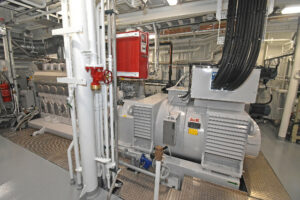
The starboard-side Wärtsilä auxiliary engine and electrical generator.
The second-generation, common-rail-driven Wärtsilä 31 engine sets a new benchmark in efficiency and overall emissions performance. Diesel fuel consumption can be as low as 165g/kWh, putting it significantly ahead of any other four-stroke diesel engine currently on the market.
Its exceptional fuel efficiency is made possible through the use of new technologies, such as two-stage turbocharging, a high-pressure fuel injection system and adjustable valve actuation, in combination with the next-generation engine control system.
The 31 range is the result of engineers at Wärtsilä starting from a completely blank slate to develop a new engine family that would be considerably more efficient than anything that had come before, rather than improving an existing design.
Designing a new engine entirely from the bottom up gave the unique opportunity to examine all of the various factors that contribute to engine efficiency, making improvements in each to achieve the greatest possible gain. Combustion quality, engine parameters, heat and flow loss prevention, and internal friction were among the issues exhaustively explored and addressed.
The most critical advance in the Wärtsilä 31 range is an engine structure designed expressly to accommodate two-stage turbocharging. While the considerable boost in efficiency associated with two-stage turbocharging was well known, no existing engines were capable of taking full advantage of the effect. They simply could not stand up to the loading and strain that results from the step change in firing pressure. To overcome this, the engineers gave the entire Wärtsilä 31 engine structure a very robust design.
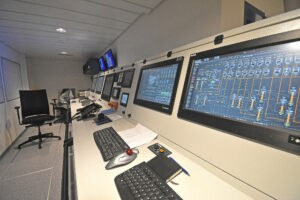
Engine control room…
A fundamental advantage of the Wärtsilä 31 is its flexibility. The engine can be continuously operated at 10% load, and can reach full load within as little as two minutes of the start command.
A major contributor to the engine’s increased flexibility is its completely redesigned valve actuation method. The new design replaced the mechanical, rocker arm-driven valve mechanism of previous models with a hydraulic system. This feature allows very smooth and precise control of valve timing, to ensure that the fuel-air ratio in the cylinder is optimised at all times. In this way, the engine can take maximum advantage of the boost provided by two-stage turbocharging, especially on partial loads.
Optimised engine parameters and adjustable inlet valve timing, combined with electronic ignition timing, result in fewer unburned hydrocarbons, and therefore vastly improved efficiency and lower emissions, irrespective of the load. An added bonus of the hydraulic valve actuation concept is that there is no need for valve clearance adjustment.
Wärtsilä 31 engines also feature a ‘next-generation’ fully integrated automation system that regulates valve timing, gas admission, ignition, coolant temperature, and various aspects of the turbocharging. All sensors are connected directly to the control ports, without going through connectors or junction boxes – changes that further enhance reliability.

… and a screen display for one of the auxiliary engines.
The Tier III-compliant 12V31 engine is part of Research’s fully-integrated Wärtsilä propulsion system, which includes a 5.9:1 reduction gearbox and a 4,300mm CP propeller system housed in a high-performance fixed nozzle. This combination of centreline machinery enabled Research to record a top speed of 18.5 knots on trials.
A PTO on the gearbox drives an AEM shaft generator delivering 4,250kVA @ 1,200rpm.
Further electrical power on Research, to meet the requirements of the deck machinery, is provided by Wärtsilä 8L20 and 6L20 engines. Positioned either side of the main engine, the 1,480kW and 1,100kW auxiliaries drive AVK generators that develop 1,771kWe and 1,100kWe respectively.
A Scania 280kW harbour genset is also fitted in the open-plan engineroom, which is arranged across the vessel’s full beam.
A John Deere emergency genset (125kWe) is housed in a secondary electrical room on the tweendeck below the wheelhouse.
The vessel’s electrical power system is fitted for sliding frequency (60-50Hz), by means of frequency converters for 400/440V and a rotating frequency converter for 230V. This arrangement allows the main engine and propeller rpm to be reduced by 17%.
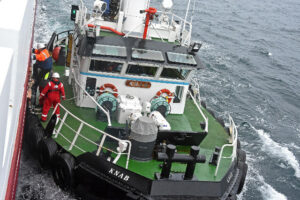
A Lerwick pilot prepares to go aboard as Research enters Lerwick harbour for the first time, before the skippers gained their pilot exemption tickets.
A Brunvoll 1,500kW Azimuth thruster fitted forward – widely used on tugs, dive support and standby vessels – provides an alternative propulsion facility in the event of main engine or gearbox failure, or if the propeller is disabled for any reason, in addition to transverse thrust. A 960kW tunnel thruster is fitted aft.
The combination of double bottom and deep fuel tanks allows 550,000 litres of fuel to be carried. The vessel’s domestic freshwater capacity is 77,000 litres. Two 80t passive anti-roll tanks are positioned forward on the boat deck, together with a 75t tank aft. Two double bottom and two aft tanks can accommodate 150t of seawater ballast, served by a dedicated MMC water treatment plant in the engineroom.
Engineers David Nicolson, Alex Wishart and Alex Fullerton monitor the performance of all the vessel’s propulsion and generating machinery, electrical supplies and catch storage from a separate soundproofed control room and office.

